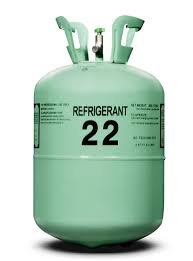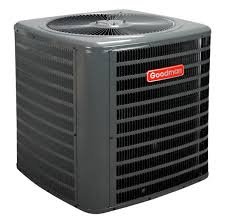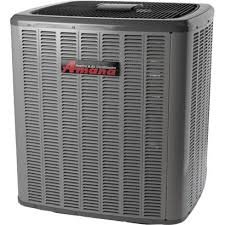
Air Conditioner Installation Alfred-Plantagenet
How does your air conditioner work?
Is it time for an AC upgrade?

Get a free quote!
Refrigerants are Changing
-

R-22
R-22, also referred to as Freon was introduced to North America in the 1950’s. It was the common refrigerant used for air conditioners and heat pumps up until 2009. It was later discovered that R-22 was one of the major contributors to Ozone layer depletion. The government has since signed on to environmental commitments to protect the ozone layer. Beginning January 1, 2020 R-22 is no longer allowed to be produced or imported into North America.
-

R-410A
In 2010 when R-22 was initially phased out, it was replaced by R-410a. R-410a refrigerant has an Ozone Depletion Rating of 0. The change was extremely successful as the Ozone layer was able to replenish itself and repair the hole.
Though this was a huge advancement for the effects on the ozone, it was later discovered that this refrigerant is a Greenhouse Gas. R-410a has a GWP (Global Warming Potential) rating of around 2088. This means it traps up to 2088 times more heat in the atmosphere compared to Carbon Dioxide.
-

A2Ls
As we continue to learn more about our environment, the effects of global warming, and the importance of taking action, the HVAC industry is continuing to shift to implement cleaner technologies.
There are now 2 new refrigerants on the Canadian market to replace both R-22 and R-410a; R-32 and R-454b. These new refrigerants are collectively referred to as A2Ls. They have Ozone Depletion Potential ratings of zero and must have GWP ratings of under 750. R-32 has been used for the last decade across Europe with a GWP of 675. R-454b is new to the market but boasts a GWP of 466. These numbers are still high but it is definitely a step in the right direction!
You may have heard these refrigerants are flammable. They are considered “mildly” flammable, meaning if you placed a source of ignition such a BBQ lighter directly at the refrigerant, it would spark. However, as soon as the source of ignition was removed, the flame would go out. In comparison, natural gas and propane are true flammable substances and are commonly used in homes every day. The use of these substances is highly regulated to keep everyone safe and comfortable.
Best Air Conditioners Alfred-Plantagenet
Goodman GLXS3B Air Conditioner
-
R32 Split System Air Conditioner
Up to 14.5 SEER2
Cooling Capacity: 18,000 - 60,000 BTU/h
500-hour salt-spray approval
-
It all begins with an idea. Maybe you want to launch a business. Maybe you want to turn a hobby into something more.
Amana ALXS3B Air Conditioner
-
R32 SPLIT SYSTEM AIR CONDITIONER
UP TO 14.5 SEER2
COOLING CAPACITY 18000 - 60000 BTU/H
HIGH DENSITY FOAM COMPRESSOR SOUND BLANKET
500 HOUR SALT SPRAY TESTED
-
Limited 10 year parts
Amana ASXS6 Air Conditioner
-
S-SERIES AIR CONDITIONER
UP TO 17.2 SEER2
INVERTER DRIVEN SIDE DISCHARGE SPLIT SYSTEM AIR CONDITIONER
HIGH DENSITY COMPRESSOR SOUND BLANKET
500 HOUR SALT SPRAY TESTED
-
See full details here.
Goodman GSXV9 Air Conditioner
-
Split System Air Conditioner
Up to 22.5 SEER2
High-efficiency variable-speed swing and scroll compressors (tonnage dependent)
High-efficiency variable-speed ECM condenser fan motor Inverter Driven
ComfortBridge Communications System compatible
Energy star “2023 Most Efficient”
-
It all begins with an idea. Maybe you want to launch a business. Maybe you want to turn a hobby into something more.
Amana ASXV9 Air Conditioner
-
High Efficiency SPLIT SYSTEM AIR CONDITIONER
UP TO 22.5 SEER2
COOLING CAPACITY 22600 - 52000 BTU/h
Variable-speed swing and scroll compressors
HIGH DENSITY FOAM COMPRESSOR SOUND BLANKET
500 HOUR SALT SPRAY TESTED
Energy Star Certified
-
Limited 10 year parts, lifetime unit replacement
Read full warranty details here.
What About Energy Efficiency?
In Alfred-Plantagenet our main energy efficiency rating is called SEER (Seasonal Energy Efficiency Rating). SEER is determined by dividing the total cooling achieved over a year divided by the amount of energy used to generate that cooling.
In 2023 a full overview of how testing is performed to evaluate SEER ratings was conducted and improvements were made to more accurately reflect real life conditions. SEER ratings are now measured as SEER2 values.
In Canada the lowest allowable SEER2 rating currently on the market is 13SEER2, with ratings typically going up to 25SEER2; the higher SEER2 ratings (over 18) generally only available for ductless/mini split systems.
In Alfred-Plantagenet it gets hot but our summers are short. This means you aren’t actually running your air conditioner for much of the year so you may not get back the extra money you invest into a more expensive air conditioner through utility savings in this amount of time.
Though you may not see much more in utility savings, the side discharge units are homeowners most preferred air conditioner units because of how quiet they are and because they are able to maintain a much more consistent indoor temperature, leaving you more comfortable all summer long.
If you expect to stay in the home for a long time, you may want to consider a heat pump. Because heat pumps are used all year long, they offer greater energy and year utility savings. You can learn more about heat pumps here.






